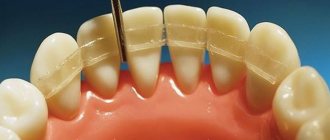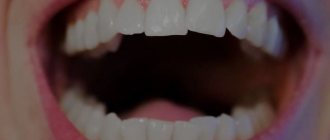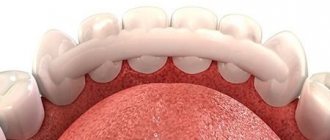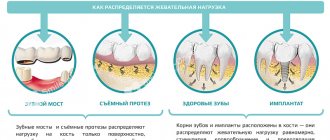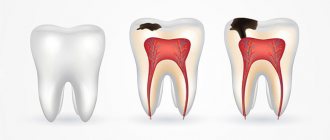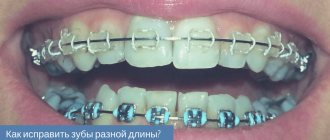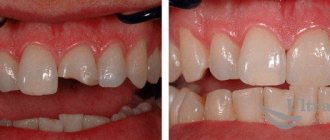- Indications
- Causes
- Consequences
- Materials
- Methods
- Stages of treatment
- Result
- Prices
- Doctors
- Reviews
Splinting of teeth is a method of fixing dental units with their abnormal mobility. The procedure involves combining two or more elements into one block structure using removable or non-removable tires. This ensures uniform redistribution of the chewing load, preserves the geometry of the jaw, and prevents further loosening and tooth loss. The doctor selects the splinting method based on the results of the examination, taking into account medical indications.
- When used:
for periodontitis, dental injuries - Treatment period:
constantly - Type of anesthesia:
depending on the situation, 2-3 visits - Procedure time:
about 1 hour - Age restrictions:
from 18 years old
The ROOTT clinic network in Moscow provides temporary and permanent dental splinting. The use of effective technologies and innovative materials ensures positive dynamics and quick results. The procedure is used when the periodontal tissues are weakened or damaged, and therefore cannot firmly hold the element in the socket.
Indications
- Pathologies of the gums and periodontium, accompanied by mobility and displacement of teeth;
- loosening of units due to jaw injury;
- exposure of roots, pronounced gum pockets;
- consolidation of the result after orthodontic treatment with braces.
Teeth are placed on splints for a short (up to 1 month) or long (up to 1 year or more) period. Maintenance therapy for periodontal disease
provides for permanent splinting. The decision on the duration of treatment and the method of fixation is selected separately in each clinical case.
Causes of mobility
The problem of loose teeth occurs in patients with gum and periodontal pathologies. Due to inflammation, the soft, bony periodontal tissues begin to gradually deteriorate. Weakened tissues are no longer able to securely hold the tooth, and it begins to wobble. Mobility occurs in the middle, advanced stage of the disease. Mobility is also caused by jaw injuries and surgical treatment of the root zone.
Dental splinting for periodontitis allows you to keep units in the correct position, reduce their mobility, and prevent loss. The advantage of the procedure is the correct redistribution of the chewing load. The main mechanical load falls on healthy units, and the affected elements strengthen and recover faster.
Reviews from satisfied clients
Sergey
Had periodontitis on three teeth. The doctor recommended a splint. At first it was scary, but in the process it turned out that it didn’t hurt at all. But the result is very pleasing. My teeth are no longer loose, I can eat calmly, without worrying about whether a tooth will fall out or not.Rodion
I would like to say a big thank you to the dentists of the 14x14 clinic. Splinting really helped me. The procedure itself was quick and painless. The price is quite reasonable.
Consequences
With periodontitis, the destruction of jaw tissue often occurs rapidly. If the moving units are not strengthened in a timely manner, they will simply fall out. And only implantation will help restore the dentition. The need for the procedure is determined by the doctor, based on the results of the examination and x-ray studies. Reviews confirm the good effectiveness of the intervention; patients quickly adapt and get used to the splint.
Alekperov Roman Borisovich Dentist-orthopedist, doctor of the highest category
What does “constant wearing” mean?
The patient does not have the ability to remove the splint until it needs to be replaced
Alekperov Roman Borisovich Dentist-orthopedist, doctor of the highest category
At what degree of periodontitis is it possible to splint teeth?
At the initial stage
Alekperov Roman Borisovich Dentist-orthopedist, doctor of the highest category
If I am afraid of surgery, is it possible to have anesthesia in advance?
No, only premedication is possible (providing psychological control to the patient by pre-administering medications)
Alekperov Roman Borisovich Dentist-orthopedist, doctor of the highest category
Can there be any complications during the operation?
No complications are possible during splinting
Materials
Today, dentistry uses different materials as splints, and not only their strength is important, but also aesthetics. The most common:
- Fiberglass;
- silk;
- armid thread;
- ceramics;
- composite;
- polyethylene.
Flexible materials create a durable splinting frame, fixed on the inside of the row. All materials are of increased strength, do not deform, do not shrink, are safe for gums and enamel, and are resistant to moisture and high temperatures. The cost of dental splinting in Moscow depends on the intervention technique, the complexity of the clinical case, and the material.
Splinting teeth with clasp dentures –
If you look closely at Fig. 16-17, you will see that in the area of the inner surface of the lower teeth the prosthesis has an additional thin arch that tightly covers each tooth. This allows the teeth to stand firmly in place and transfer the chewing load from themselves to such a metal arch, without experiencing overload.
The big advantage of such dentures is that they allow you not only to splint mobile teeth, but also to simultaneously restore missing teeth. Read more about this type of prosthesis here .
Therapeutic method
The therapeutic approach involves “tying” the moving elements together with fiberglass tape or armid thread and securing them with filling material. Depulpation is not needed for intervention. Having assessed the condition of the gums, the following types of splinting of the front teeth are used:
- Extracoronary
– the splint is fixed to the enamel surface with dental cement. - Intracoronary
- the splinting element is placed in a small groove on the enamel and secured with a filling composite. Splinting of the upper teeth is performed from the outside, and of the lower teeth from the inside. When laying the thread on the chewing units, a groove is made at the top to ensure better fixation. The tape or thread is applied to the elements that are loose, and to healthy units too. - Occlusal
- splints or retainers act as a splint.
Therapeutic treatment is indicated when all units are present in the row. Splinting teeth with fiberglass tape or armid thread is a gentle method, since it does not involve severe trauma to the coronal part or depulpation.
Care after installation
Caring for dentures is practically no different from caring for “natural” dentures and includes the following steps:
- daily brushing of teeth and tongue twice a day (morning and evening);
- regular cleaning of the space under dentures and interdental spaces (it is recommended to use an irrigator and dental floss for these purposes);
- exclusion of too hard foods from the diet, proper nutrition, avoidance of sudden temperature changes;
- using mouth rinses after every meal;
- control of gum condition.
In addition, many dentists advise that after dental prosthetics with crowns, regularly massage the gums underneath them to stimulate blood circulation and normalize local metabolic processes. You need to massage your gums in smooth circular movements counterclockwise and clockwise.
In Moscow, you can install dentures at a dental clinic. You can make an appointment for the procedure of dental prosthetics with crowns by filling out a simple online form on the website or by calling.
Orthopedic method
This method of treatment is used in the absence of one or more units. To fix moving elements, fixed orthopedic crowns and removable clasp dentures are used. The structures are made from an impression of the patient’s jaw, which makes them comfortable to wear. Crowns and prostheses reliably hold moving elements and also replace missing ones, restoring the full functionality of the row.
When are dental crowns needed?
Dentists have identified the following indications for the installation of this type of prosthesis:
- Destruction of the crown part of the tooth by more than 50%. Most often, this situation occurs with severe caries or with injuries. In this case, a crown is installed to protect the tooth from further destruction.
- Protection of pulpless teeth. Removing a nerve from a dental canal is accompanied by a weakening of the enamel - it becomes fragile, so it is quite advisable to protect it with a crown.
- Any aesthetic defects: tetracycline teeth, fluorosis.
By contacting the AcademyDENT clinic, you are guaranteed to receive a qualified consultation with a doctor who will tell you exactly whether you need a dental crown or whether other treatment methods are possible.
Stages of the procedure
The procedure for splinting teeth on the lower jaw and upper jaw is performed using the same technology
- Anesthesia
- the drug is selected taking into account the general condition (sensitivity to painkillers, pregnancy, allergies, etc.). - Forming
grooves of the required depth (up to 1 mm) on the enamel (just above the gingival margin) from the inside of the tooth using a spherical bur. - Place
fiberglass tape or armid thread in the furrow, on loose and healthy units. - Filling the cut
with a composite or light-curing material selected to match the shade of the enamel.
Splinting of chewing teeth involves creating a groove not on the inner surface of the molars, premolars, but on top - for more reliable fixation. To eliminate the mobility of chewing teeth, an aramid thread of increased strength is often used. A fiberglass splint is placed on the front incisors - the tape is aesthetic, invisible when talking, smiling, and can be easily removed.
If more than 4-5 units
, the row is splinted with a clasp prosthesis or crowns. Using fiberglass or aramid thread is not advisable, since the result cannot be preserved for a long time. Crown installation technology:
- depulpation and filling of root canals;
- giving dental units the desired shape (turning);
- installation of permanent orthopedic crowns.
The clasp prosthesis simultaneously strengthens the movable units and replenishes the lost ones. It is installed in a gentle way, but the metal elements of the prosthesis are visible when smiling or talking. Splinting the front teeth with crowns provides a more aesthetic result.
Kinds
Today in dentistry, the following types of crowns are most often used for dental prosthetics:
- metal-ceramic. They have a durable metal frame and are lined with ceramics on top. The advantages of dental prosthetics with metal-ceramic crowns include strength, aesthetics, long service life - up to 15 years;
- ceramic. Metal-free ceramics are the best option when it comes to dental prosthetics with crowns in aesthetically significant areas. The advantages of dental prosthetics with ceramic crowns: hypoallergenic, high aesthetics, service life up to 20 years, no need for extensive preparation of healthy teeth;
- zirconium. Prostheses made from zirconium dioxide are the most durable and reliable. Advantages of dental prosthetics with zirconium dioxide crowns: high biocompatibility, excellent aesthetics, ability to withstand heavy loads, wear resistance, minimal grinding, service life up to 20 years;
- metal. These are the predecessors of modern dentures, which are used less and less in modern dentistry. They are made from an alloy of chromium and cobalt. Outwardly, they are very different from healthy units, so they are placed in the chewing department. The advantages of dental prosthetics with metal crowns: high strength, minimal grinding of supporting teeth, low price.
Result
Splinting teeth using reliable materials and structures can significantly reduce the mobility of elements and restore chewing function. A rigid, but at the same time elastic tire binds the elements into one block, holding them securely and preventing them from loosening further. The more units covered by the bus, the better the result. Tire service life is 3-4 years. The biocompatible material does not irritate the mucous membrane, does not injure the gums, and does not interfere with hygiene.
Article Expert
Kopylova Lyubov Ivanovna Dentist-therapist, doctor of the highest category
Work experience: more than 12 years
Application of aramid thread
This splinting method is called cable-stayed. Its technology is similar to the use of fiberglass. The use of this material makes it possible to strengthen the strength of the teeth. The thread is laid in horizontal grooves and fixed with filling material. The procedure is considered natural, from a physiological point of view, and therefore has become widespread. In addition to good fixation of teeth, this method improves their color.
Dentists prefer aramid tape due to its long service life, high degree of strength and good compatibility with tooth enamel. In addition, this material does not interact with saliva and food. Other materials do not have these characteristics. The advantages of cable-stayed splinting include the following factors:
- the risk of reducing the volume of the jaw bones is minimal;
- even with severe loosening, teeth can be saved;
- the laid thread allows you to evenly distribute the load on the teeth;
- simultaneously with splinting, the doctor carries out complex therapeutic and surgical treatment;
- During the operation, the teeth are not ground and the pulp is not removed;
- There is virtually no injury to teeth and gums;
- After filling the groove with composite material, the patient has no doubts about the formation of caries;
- aramid thread does not interfere with oral care;
- the thread does not prevent the doctor from carrying out preventive and therapeutic manipulations;
- the aesthetic appeal of teeth is preserved;
- long lasting results after a dental procedure.
Complications occur extremely rarely. This can happen due to doctor error. For example, the groove for laying the thread passes close to the pulp, which leads to damage to the chamber. An allergy to the material used in the products may occur. To prevent this from happening, you should take allergen tests in advance. Sometimes patients are sensitive to the enamel. This usually happens if cleaning was carried out the day before the splinting operation.
Based on the reviews and comments that can be read on the Internet, one can judge this unique method. People share their experiences, they write about how significantly the condition of their teeth and gums has improved. Such comments and advice are an excellent option for doubting patients.
Advantages of treatment at the RUTT clinic
The RUTT network of clinics approaches the problem of dental mobility in a comprehensive manner. Treatment is aimed at eliminating the cause of the pathology. In addition to splinting, patients undergo a number of other measures - professional hygiene, therapy of periodontal canals with the Vector device, injections, curettage, physiotherapy, etc. The clinic performs permanent, temporary splinting of the lower teeth.
- Permanent intervention is performed for a period of 12 months or more. The procedure is indicated for mobility of grades 1 and 2, at the first stage of periodontitis, when the jaw bone has not yet been destroyed.
- Temporary fixation of the splint is intended for up to 6 months, if there is a chance of losing loose teeth, but it is small. Also, temporary structures are installed after jaw injuries (fracture, etc.).
The price for splinting teeth in Moscow depends on the technique, materials, and the number of moving elements. The cost of treatment in ROOTT dentistry is formed on a turnkey basis.
Contraindications
It is not possible to install a crown on every tooth - there are certain situations when the feasibility of its installation is highly questionable. Contraindications include:
- pathological tooth mobility;
- insufficient height of the tooth crown - in this case the prosthesis will sink;
- chronic inflammatory processes in the mouth;
- unfilled canals of the prosthetic tooth.
At AcademyDENT, doctors carefully follow all indications and contraindications for prosthetics, so we have an extremely low percentage of complications.

